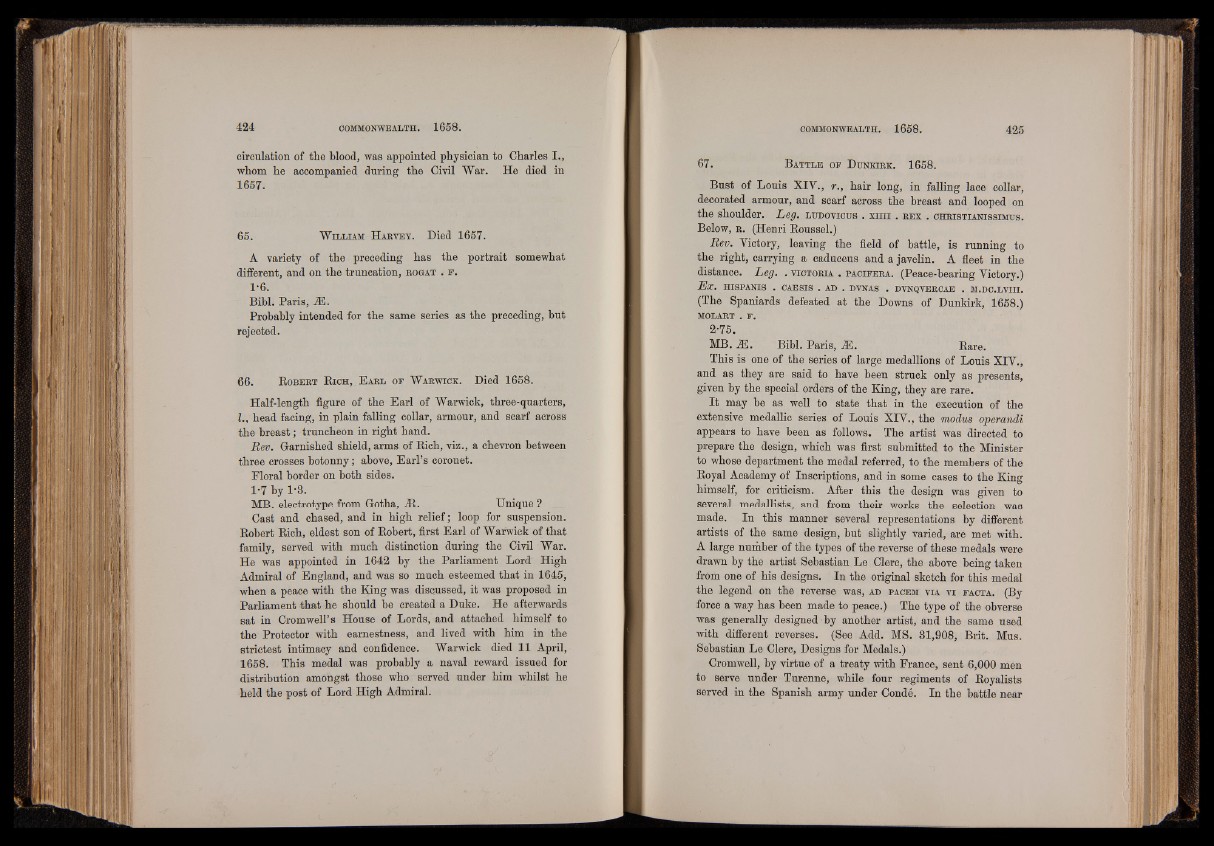
circulation of the blood, was appointed physician to Charles I.,
whom he accompanied during the Civil War. He died in
1657.
65. William Harvey. Died 1657.
A v a r i e ty o f t h e p r e c e d in g h a s t h e p o r t r a i t s om ew h a t
d if f e r e n t, a n d o n t h e t r u n c a t i o n , rogat . f .
1-6.
Bibl. Paris, JE.
Probably intended for the same series as the preceding, but
rejected.
66. B o b e r t B ic h , E a r l o f W a rw ic k . Died 1658.
Half-length figure of the Earl of Warwick, three-quarters,
I., head facing, in plain falling collar, armour, and scarf across
the breast; truncheon in right hand.
Rev. Garnished shield, arms of Bich, viz., a chevron between
three crosses botonny; above, Earl’s coronet.
Floral border on both sides.
1-7 by 1-3.
MB. electrotype from Gotha, At. Unique ?
Cast and chased, and in high relief; loop for suspension.
Bobert Bich, eldest son of Bobert, first Earl of Warwick of that
family, served with much distinction during the Civil War.
He was appointed in 1642 by the Parliament Lord High
Admiral of England, and was so much esteemed that in 1645,
when a peace with the King was disc.ussed, it was proposed in
Parliament that he should be created a Duke. He afterwards
sat in Cromwell’s House of Lords, and attached himself to
the Protector with earnestness, and lived with him in the
strictest intimacy and confidence. Warwick died 11 April,
1658. This medal was probably a naval reward issued for
distribution amongst those who served under him whilst he
held the post of Lord High Admiral.
67. B a t t l e o f D u n k ir k . 1658.
Bust of Louis XIV., r., hair long, in falling lace collar,
decorated armour, and scarf across the breast and looped on
the shoulder. Leg. lu d o v ic u s . xmi . r e x . c h r is t ia n is s im u s .
Below, r . (Henri Boussel.)
Rev. Victory, leaving the field of battle, is running to
the right, carrying a caduceus and a javelin. A fleet in the
distance. Leg. . v ic to r ia . pa c if e r a . (Peace-bearing Victory.)
Ex. HISPANIS . CAESIS . AD . DVNAS . DVNQVERCAE . M.DC.LVIII.
(The Spaniards defeated at the Downs of Dunkirk, 1658.)
MOLART . F.
2-75.
MB. M. Bibl. Paris, M. Bare.
This is one of the series of large medallions of Louis XTV.,
and as they are said to have been struck only as presents,
given by the special orders of the King, they are rare.
It may be as well to state that in the execution of the
extensive medallic series of Louis XIV., the modus operandi
appears to have been as follows. The artist was directed to
prepare the design, which was first submitted to the Minister
to whose department the medal referred, to the members of the
Boyal Academy of Inscriptions, and in some cases to the King
himself, for criticism. After this the design was given to
several medallists, and from their works the selection was
made. In this manner several representations by different
artists of the same design, but slightly varied, are met with.
A large number of the types of the reverse of these medals were
drawn by the artist Sebastian Le Clerc, the above being taken
from one of his designs. In the original sketch for this medal
the legend on the reverse was, ad pa c em v ia v i fa c ta . (By
force a way has been made to peace.) The type of the obverse
was generally designed l y another artist, and the same used
with different reverses. (See Add. MS. 31,908, Brit. Mus.
Sebastian Le Clerc, Designs for Medals.)
Cromwell, by virtue of a treaty with France, sent 6,000 men
to serve under Turenne, while four regiments of Boyalists
served in the Spanish army under Conde. In the battle near